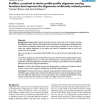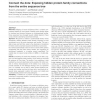146 search results - page 13 / 30 » Evolutionary design of the energy function for protein struc... |
BMCBI
2008
13 years 7 months ago
2008
Background: A multiple sequence alignment (MSA) generated for a protein can be used to characterise residues by means of a statistical analysis of single columns. In addition to t...
BMCBI
2005
13 years 7 months ago
2005
Background: Profile-profile methods have been used for some years now to detect and align homologous proteins. The best such methods use information from the background distributi...
GECCO
2000
Springer
13 years 11 months ago
2000
Springer
We present a new representation for a genetic algorithm to evolve molecular structures representing possible drugs that bind to a given protein target receptor. Our representation...
ECCB
2008
IEEE
14 years 1 months ago
2008
IEEE
Motivation: Mapping of remote evolutionary links is a classic computational problem of much interest. Relating protein families allows for functional and structural inference on u...
BMCBI
2007
13 years 7 months ago
2007
Background: Protein remote homology detection is a central problem in computational biology. Most recent methods train support vector machines to discriminate between related and ...


